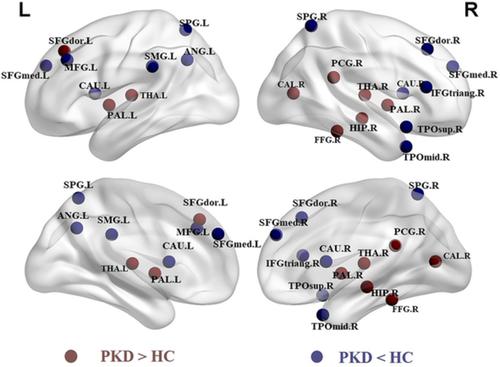当前位置:
X-MOL 学术
›
Hum. Brain Mapp.
›
论文详情
Our official English website, www.x-mol.net, welcomes your feedback! (Note: you will need to create a separate account there.)
Disruption of gray matter morphological networks in patients with paroxysmal kinesigenic dyskinesia
Human Brain Mapping ( IF 4.8 ) Pub Date : 2020-10-15 , DOI: 10.1002/hbm.25230 Xiuli Li 1, 2 , Du Lei 1, 3 , Running Niu 2 , Lei Li 1 , Xueling Suo 1 , Wenbin Li 1 , Chen Yang 1 , Tianhua Yang 4 , Jiechuan Ren 4 , Walter H L Pinaya 5, 6 , Dong Zhou 4 , Graham J Kemp 7 , Qiyong Gong 1, 8, 9
Human Brain Mapping ( IF 4.8 ) Pub Date : 2020-10-15 , DOI: 10.1002/hbm.25230 Xiuli Li 1, 2 , Du Lei 1, 3 , Running Niu 2 , Lei Li 1 , Xueling Suo 1 , Wenbin Li 1 , Chen Yang 1 , Tianhua Yang 4 , Jiechuan Ren 4 , Walter H L Pinaya 5, 6 , Dong Zhou 4 , Graham J Kemp 7 , Qiyong Gong 1, 8, 9
Affiliation

|
This study explores the topological properties of brain gray matter (GM) networks in patients with paroxysmal kinesigenic dyskinesia (PKD) and asks whether GM network features have potential diagnostic value. We used 3D T1‐weighted magnetic resonance imaging and graph theoretical approaches to investigate the topological organization of GM morphological networks in 87 PKD patients and 115 age‐ and sex‐matched healthy controls. We applied a support vector machine to GM morphological network matrices to classify PKD patients versus healthy controls. Compared with the HC group, the GM morphological networks of PKD patients showed significant abnormalities at the global level, including an increase in characteristic path length (Lp) and decreases in local efficiency (Eloc), clustering coefficient (Cp), normalized clustering coefficient (γ), and small‐worldness (σ). The decrease in Cp was significantly correlated with disease duration and age of onset. The GM morphological networks of PKD patients also showed significant changes in nodal topological characteristics, mainly in the basal ganglia‐thalamus circuitry, default‐mode network and central executive network. Finally, we used the GM morphological network matrices to classify individuals as PKD patients versus healthy controls, achieving 87.8% accuracy. Overall, this study demonstrated disruption of GM morphological networks in PKD, which might extend our understanding of the pathophysiology of PKD; further, GM morphological network matrices might have the potential to serve as network neuroimaging biomarkers for the diagnosis of PKD.
中文翻译:

阵发性运动源性运动障碍患者灰质形态网络的破坏
本研究探讨了阵发性运动源性运动障碍 (PKD) 患者脑灰质 (GM) 网络的拓扑特性,并询问 GM 网络特征是否具有潜在的诊断价值。我们使用 3D T1 加权磁共振成像和图论方法来研究 87 名 PKD 患者和 115 名年龄和性别匹配的健康对照的 GM 形态网络的拓扑组织。我们将支持向量机应用于 GM 形态网络矩阵,以对 PKD 患者与健康对照进行分类。与 HC 组相比,PKD 患者的 GM 形态网络在全局水平上表现出明显的异常,包括特征路径长度(Lp)增加和局部效率降低(E loc)、聚类系数 ( Cp )、归一化聚类系数 ( γ ) 和小世界性 ( σ )。Cp下降与病程和发病年龄显着相关。PKD患者的GM形态网络也表现出节点拓扑特征的显着变化,主要在基底神经节-丘脑回路、默认模式网络和中央执行网络中。最后,我们使用 GM 形态网络矩阵将个体分类为 PKD 患者与健康对照,准确率达到 87.8%。总体而言,这项研究证明了 PKD 中 GM 形态网络的破坏,这可能会扩展我们对 PKD 病理生理学的理解;此外,GM 形态网络矩阵可能具有作为网络神经影像学生物标志物用于诊断 PKD 的潜力。
更新日期:2020-10-15
中文翻译:

阵发性运动源性运动障碍患者灰质形态网络的破坏
本研究探讨了阵发性运动源性运动障碍 (PKD) 患者脑灰质 (GM) 网络的拓扑特性,并询问 GM 网络特征是否具有潜在的诊断价值。我们使用 3D T1 加权磁共振成像和图论方法来研究 87 名 PKD 患者和 115 名年龄和性别匹配的健康对照的 GM 形态网络的拓扑组织。我们将支持向量机应用于 GM 形态网络矩阵,以对 PKD 患者与健康对照进行分类。与 HC 组相比,PKD 患者的 GM 形态网络在全局水平上表现出明显的异常,包括特征路径长度(Lp)增加和局部效率降低(E loc)、聚类系数 ( Cp )、归一化聚类系数 ( γ ) 和小世界性 ( σ )。Cp下降与病程和发病年龄显着相关。PKD患者的GM形态网络也表现出节点拓扑特征的显着变化,主要在基底神经节-丘脑回路、默认模式网络和中央执行网络中。最后,我们使用 GM 形态网络矩阵将个体分类为 PKD 患者与健康对照,准确率达到 87.8%。总体而言,这项研究证明了 PKD 中 GM 形态网络的破坏,这可能会扩展我们对 PKD 病理生理学的理解;此外,GM 形态网络矩阵可能具有作为网络神经影像学生物标志物用于诊断 PKD 的潜力。


























 京公网安备 11010802027423号
京公网安备 11010802027423号